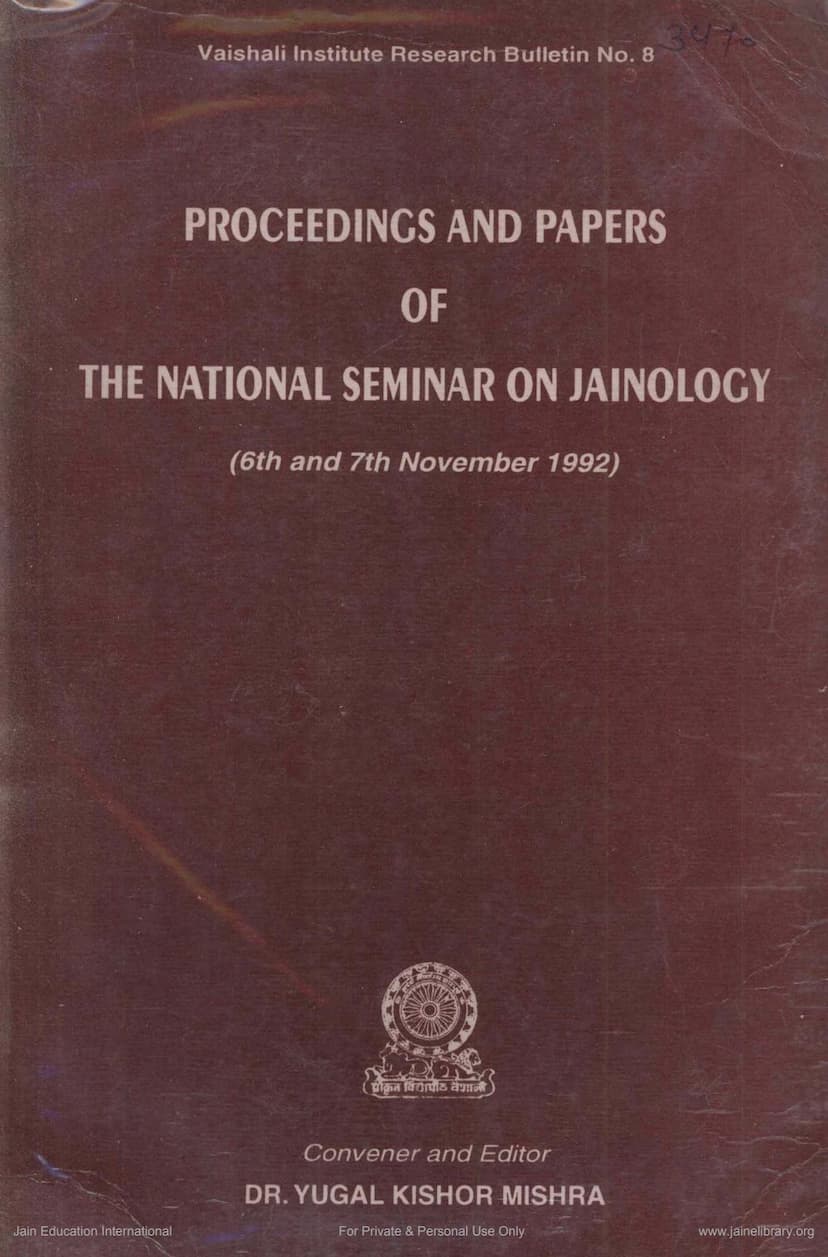Proceedings And Papers Of National Seminar On Jainology
Added to library: September 2, 2025

Summary
This document is a collection of the proceedings and papers from the National Seminar on Jainology held on November 6th and 7th, 1992, at the Research Institute of Prakrit, Jainology & Ahimsa in Vaishali. The publication was edited by Dr. Yugal Kishore Mishra, the Director of the institute.
The seminar aimed to revive and promote advanced research and studies in Prakrit and Jainology, and to disseminate the high ideals of life and humanism presented in Jain teachings to a wider audience, including rural communities. The proceedings include a foreword by A.K. Biswas, Commissioner of Tirhut Division, highlighting the importance of the seminar and the institute's role. The editorial section by Dr. Yugal Kishore Mishra expresses gratitude to the participants and acknowledges the challenge of not receiving all submitted papers in written form.
The seminar covered various aspects of Jainology, divided into three main sections:
Section 1: Jain History & Archaeology This section focused on historical and archaeological aspects of Jainism. Papers discussed topics such as:
- Jainism in Bihar during the Gupta and Pala periods, noting the decline in royal patronage and the religion's gradual shift westward.
- Observations on the Navagraha cult in Jain art, detailing iconographic features from various Jain texts for different planets.
- Trade in the Samaraichchakahā, an analysis of references to commercial activities, challenges faced by traders (like robbers and feudal lords), and the predominantly luxury-oriented nature of trade during the early medieval period.
- The archaeological significance of Videha and Mithila in Jainism.
- The presence of Jainism in the Chotanagpur region.
- The Tirthankaras, Acharyas, and Jain literature.
- Life scenes of non-Jina Shalaka Purushas in sculptures.
- Tirthankaras mentioned in the Trishashti Shalakapurusha Charita.
- Jainism in Sri Lanka, noting its historical presence and eventual decline.
Section 2: Prakrit Jainology: Language & Literature This section delved into the linguistic and literary contributions of Jainism. Papers covered:
- Jatasinghanandi's Varangcharita and its tradition, suggesting its connection to the Yapaniya or Kurchaka traditions rather than the Digambara tradition due to certain doctrinal differences and textual influences.
- The Khandakathas (fragmentary narratives) in Vasudevahindi, analyzing their classification and narrative purposes, many of which lead to religious teachings.
- Similarities and differences between the lives and thought-processes of Mahavira and Buddha.
- Prakrit-Apabhramsa prosody: tradition and development, discussing the evolution of metrical forms from Vedic times through Prakrit and Apabhramsa, with a focus on the shift from vowel-based to syllable-based metrical units and the influence of folk traditions.
- The contribution of Jain poets in Hindi to spiritual allegorical poetry.
Section 3: Jain Religion & Philosophy This section explored the philosophical and religious tenets of Jainism. Topics included:
- A comparative study of Pali Sakkāya and Prakrit Atthikāya, highlighting their etymological similarities and ontological differences, suggesting the Buddha may have adapted the Jain concept of Atthikāya for his own philosophy.
- The distinctiveness of Jain philosophy, particularly focusing on Anekantavada (multi-sidedness of reality) and its practical implications for tolerance and mutual respect in contemporary society.
- The origin and development of the Gunasthana doctrine, analyzing its presence (or absence) in early Jain texts like Tattvarthasutra and Kashayapahuda, and tracing its gradual evolution through different periods and sects.
- Anekantavada and Ahimsa: A scholarly review, discussing Anekantavada as a foundation for peace and harmony, and Ahimsa as a universal principle of respect for all life, applicable from the smallest insect to human beings, emphasizing its broad interpretation beyond mere physical non-violence.
- The five great vows of Jainism (Panch Mahavrata) in the contemporary context, highlighting their relevance for individual and societal well-being.
- An evaluation of Jain conduct (Achara), emphasizing its practical application and its basis in Jain philosophy and religion.
- The concept of the supreme reality in Hinduism and Jainism, noting similarities and differences in their approaches to the ultimate truth.
- Renunciation-dharma as described in the Uttaradhyayana Sutra, focusing on the importance of detachment from desires, the practice of asceticism, and the pursuit of self-control for spiritual liberation.
- Mahavira's five-fold Mahavrata and the three 'Da' principles from the Brihadaranyaka Upanishad, analyzing their shared emphasis on self-control and ethical conduct for human welfare.
- An analysis of the self (Atmatattva) in Jain philosophy, contrasting it with other Indian philosophical schools and highlighting its unique characteristics.
The keynote address was delivered by Professor Basant Kumar Lal, on "The Contemporary Relevance of Jain Principles," which set the tone for the seminar's discussions. The inaugural address by Padmashri K.N. Prasad touched upon the historical significance of Vaishali and the enduring relevance of the teachings of Mahavira and Buddha in the modern world, particularly in promoting moral values and harmony. The presidential address by Dr. Ramji Singh emphasized the reassessment of philosophical principles to find solutions to life's problems and highlighted Anekantavada and Ahimsa as vital to contemporary India and the world. The concluding address by Shri Gorakh Prasad stressed the need to follow and propagate the message of the seminar amidst rising religious fanaticism globally.
The proceedings thus provide a valuable compilation of scholarly research on various dimensions of Jainology, reflecting the intellectual discourse and contemporary relevance of Jain traditions.